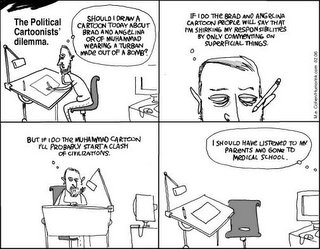I did not know
Perwez Shahabuddin but two of my very dear friends did. An IIT Delhi graduate, MS and PhD from Stanford, Professor at Columbia University, Perwez
committed suicide in a Days Inn motel room in November 2005.
A copy of the book
'Final Exit' was found by his body. This is a 'how to' manual for terminally ill people who want to end their life. Of course, people use it to learn about painless ways to commit suicide as well.
His wife says Perwez had called that evening asking if he should bring home some groceries. The family
cannot believe he would have taken his own life. But the police say that the professor's computer indicated he may have been
planning this 'final exit' for a long time.
Last night television actress
Kuljeet Randhawa was found hanging from the ceiling of her Juhu home. Again, there is disbelief among family and friends. They had no idea she was contemplating such an extreme step. But then neither did those who knew IITian
Vijay Nakula.
Kuljeet was a close friend of model
Nafisa Joseph, who committed suicide in 2004. Before that there was
Natasha Singh. And of course there are many, many less high profile cases of suicide in the newspapers everyday.
All these individuals suffered from clinical depression. In some cases, they successfully 'hid' it from the world. In Nafisa's case, she was actually under treatment. But none of them ever imagined
aisa mere saath ho sakta hai.
But, it canA few years ago I read about how depression would overtake heart disease as the world's number one killer disease. I laughed back then but here's the deal:
Approximately 20-25% of women and 12% of men will experience a serious depression at least once in their lifetimes. Of those who have experienced a major depression once before, approximately half may experience it once again. I have. And I know many of you will as well. Which is why I am sharing with you today something that I wrote shortly after Nafisa Joseph's death - a year and a half ago.
I publish it now because I think it's time we shake off the stigma attached to any form of mental illness. The fact that I waited so long to share my experience shows that even in my mind, the doubt of 'log kya kahenge' exists.
Yes, I was once depressed. I kicked it. It wasn't easy but I emerged a better and stronger person for it. Know that it could happen to you. Know that you too can kick it.Don't hesitate to seek help. Or to reach out and help others. This, is my way.
Inside the Black Hole and Beyond- Rashmi Bansaloriginally written, August 2004
(but never before published)Every act of life, from the morning toothbrush to the friend at dinner, became an effort. I hated the night when I couldn't sleep and I hated the day because it went toward night. - F. Scott Fitzgerald, author of The Great Gatsby
Astronomers define the Black Hole as a region where matter collapses into an object so massive and dense that nothing, not even light, can escape its gravitational pull. Depression is something like that.
A hole in your soul which sucks in and obliterates all that you are, all that you lived for - love, learning, laughter. It’s the human mind, collapsing into something so massively negative and dense that nothing, not even hope, an escape its gravitational pull.
And sometimes it seems like there’s just one possible escape from the pain. Suicide.
Those of us who have not been in this state of mind cannot begin to imagine what it feels like. Those of us who have, say a silent prayer for Nafisa and keep our secret. In another time and that faraway, forlorn place, the thoughts that crossed our mind… We lived to tell the tale, but never actually tell it.
Folks with B.P. and cholestorol problems swap stories. Slipped disc slips into conversation easily. Diabetics don’t shy from describing their condition. Bet you know more folks suffering from all of the above than you can count on the fingers of your two hands.
But do you know anyone who has been or currently is clinically depressed? You probably do, except you don’t know it.Astronomical black holes cannot be seen directly (they emit no light, remember!). But they can be detected by their effect on surrounding clouds and stars. The walking and talking human black hole is similar. Rarely will you get a direct confirmation or admission of what’s going inside such a person’s head. ("He/ she seemed so normal…" is the common refrain of near and dear ones).
But there always are a number of indirect signs and signals. Except, with each of us luxuriating in our own little worlds and feeding off our own little problems, who was really listening? And even if someone did listen what would their response be beyond trying to ‘cheer you up’.
It doesn’t work and after a while, the world will conclude you are happy to be unhappy and command you to "Snap out of it". As if the clinically depressed person doesn’t
want to.
Remember the black hole? Logic doesn’t work in that zone. Willpower is not enough. Depression is a medical condition. It’s a permanent fog in the head caused by a chemical imbalance. The neuro transmitters that regulate emotions, reactions to stress, and basic drives like sleep, appetite, and sexuality aren’t doing their job. If it were that simple, you could simply pop a pill and get over it, like a stomach upset. But, the physical symptoms are rooted in psychological ones.
Clinical depression is literally seeing the world through a pair of dark glasses that distort and colour with gloom your view of everything – including yourself. It’s this distortion that causes the chemical balance in the first place.
The cycle feeds on itself and soon enough the negative 'spin' you give to everyday events and interactions develops a force of its own. You are, effectively, trapped in that metaphysical black hole.
Why we actually don these blinkers is the subject of intense research. Genetics plays a role, as do personality traits. Introverts, perfectionists, and over-achievers are all more prone to depression. So are creative people – like artists and writers. By these yardsticks, I was a sitting duck.
And if that weren’t enough, women are twice as likely to develop a major depressive episode as men. However, they’re also more likely to recognize the problem and seek help for it, which is what I did.
To cut a long story short, a dapper doc diagnosed the disorder as ‘
dysthmia’. Never heard the term, have you? Well, get this. It’s a low grade, chronic form of depression. Not as severe as ‘major depression’ but something that stays with you so long you just assume you’re 'like that only'. Dysthmics even appear to function normally, they just don’t feel excited or happy about anything. Actually, they mostly don’t feel at all.
The medication doc prescribed was great. No it didn’t give a 'high' but it was like taking a mood elevator upto the very tippy top of the Petronas Towers. Emotionally Teflon coated, I felt like a whole new person. But that was part of the problem. I didn’t want to be another person. I wanted to be ‘me’.
That’s where the 'talking it out' bit kicks in. Cognitive behaviour therapy makes you realize the negative patterns of thinking you’ve entangled yourself in. And bit, by bit, a skilled professional can help you unravel the mess.
An important lesson I learnt: finding the right psychotherapist is like finding the perfect pair of jeans. If the first pair you try doesn’t fit, you don’t give up, right?Well, the second shot hit bulls eye, and thanks to a very empathetic and perceptive counselor I became aware of the importance of 'self talk' . The constant chatter in our heads that most of us are barely aware of, but which shapes how we think about ourselves. And therefore feel, and act. A depressive state arises when our internal 'critic' becomes vicious and
literally attacks us.
The result of this constant negative feedback in our own heads is low self esteem - feeling worthless and hopeless. It doesn’t matter how beautiful, rich or successful you might appear to the outside world. Or how ‘strong’ you have always seemed to be. In your own thoroughly warped view of the world, your life sucks completely.
The other trap you’ll find a clinically depressed person in: 'learned helplessness'. For example, after several failed relationships, you might be convinced that 'no matter what I do I'll never be in the right relationship'. And lo, it becomes a self fulfilling prophecy. When, with the help of therapy, a depressed person is able to generate alternative possibilities and explanations for why things happen, he or she begins to at last see the light.
Until then, words like 'always', 'never', 'perfect' and 'impossible' dominate your thinking. When you screw up on something it’s 'I’m a complete idiot' or 'I’m never able to get things right' and not 'Oops, I goofed up this time'. Recognise and clamp down on the use of this 'all or nothing' vocabulary and the entire perspective changes. This is but obvious to 'normal' people but a huge revelation when you are in the twilight zone.
Of course, nothing is as simple as it sounds. You can accept these arguments at an intellectual level and still be unable to actually 'change' or adopt new patterns of behaviour.
It’s a slow, sometimes frustrating process but one that gradually builds the emotional velocity to escape from that black hole. And one fine day you realize – “I did it!”
Like diabetics who need to watch their insulin levels, a person who has once been depressed always needs to be vigilant. Because there are times when you can sight that black hole in the distance. It’s only human to feel sad and low at times, but relapsing into the old and negative patterns of thinking is what you constantly have to guard against.
Rediscovering the people, places and passions you really enjoy is one habit you have to carry on. With me, that meant reconnecting with the one thing that had always made me happy but which somewhere along the way I’d lost faith in – writing. It also meant making the time and effort to meet with friends I had lost touch with, and to keep the ‘crazy’ side of me alive.
As for the Black hole. As in metaphysics, so in astrophysics. There are no absolutes. After nearly 30 years of arguing that a black hole destroys everything that falls into it, Stephen Hawking recently admitted
he was wrong. It seems that black holes may after all allow information within them to escape.
It is in fact now believed that the black hole eventually shrinks to a tiny kernel, at which point a growing torrent of radiation begins to leak out. So, if an object falls into a black hole it is not completely obliterated. Instead, the black hole is altered as it absorbs the object.
Something similar holds true for the human soul. You emerge from the ‘black hole’ not as a diminished but a different, often much richer and more empathetic person. The old Rashmi would never have shared this experience. The new one has.
Because there are too many people out there I can recognize now, spinning in their private black holes. Unable to open the door when opportunity, and happiness comes knocking. "It’s not the end of the world", I want to say to them all.
Why me, is a question many of you must be asking. Well, as a wise man once put it: "One ceases to recognize the significance of mountain peaks if they are not viewed occasionally from the deepest valleys." The view from up here – it’s truly beautiful.
Useful: Identifying
clinical depressionFacts about depression: - According to the WHO unipolar depressive disorder is the leading cause of disease burden or DALY (disease adjusted life years) for females globally.
- Nearly twice as many women as men are affected each year. Some of this is accounted for by frequent changes in hormone levels of women (eg depression is common at the time of menopause or after childbirth).
- Men may be less willing to acknowledge their emotional symptoms and more apt to suppress their depression through the use of alcohol or other substances. In such cases depression can be "masked," or viewed only as alcohol or drug dependency/abuse rather than as clinical depression.
Research indicates that depression onset is occurring earlier in life today than in past decades.- Upto 2.5 percent of children and 8.3 percent of adolescents in the U.S. are believed to suffer from depression.
Depression helpline numbersSumaitri (Delhi): 2371 0763
Sanjeevani Society for Mental Health (Delhi): 4311918/ 4317285
The Samaritans (Mumbai): 23092068
Prerna (Mumbai): 25905959
Maithri (Kochi): 0484 2396 272 (/3)
Sneha (Chennai): 28273456
Alternatively, ask your family doctor to refer you to a mental health professional
 Business Today magazine has pubished its annual list of 25 most powerful women in Indian business. Rather than individual names, the trends thrown up by the listing are interesting:
Business Today magazine has pubished its annual list of 25 most powerful women in Indian business. Rather than individual names, the trends thrown up by the listing are interesting:

 This time, all 3 of the amazing women on the BT cover kind of looked like they were ready to leave for a party. Personally, I think they look far more elegant in the more sober clothes they have been photographed in, inside the magazine.
This time, all 3 of the amazing women on the BT cover kind of looked like they were ready to leave for a party. Personally, I think they look far more elegant in the more sober clothes they have been photographed in, inside the magazine. 













